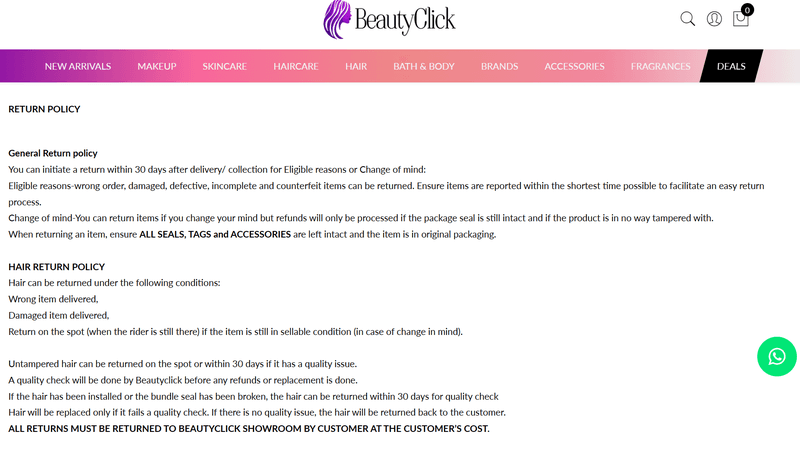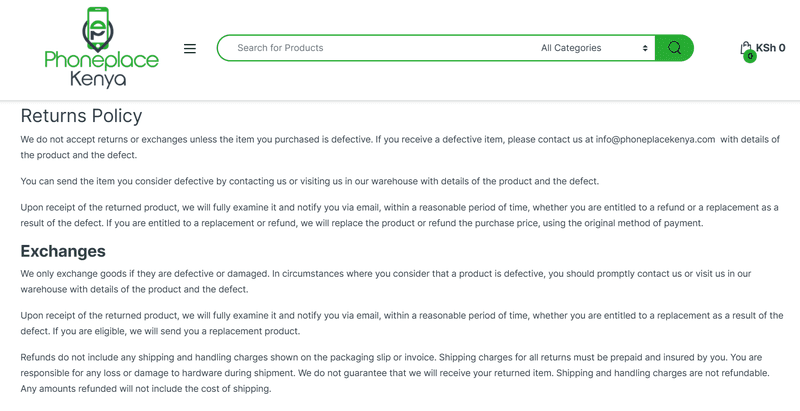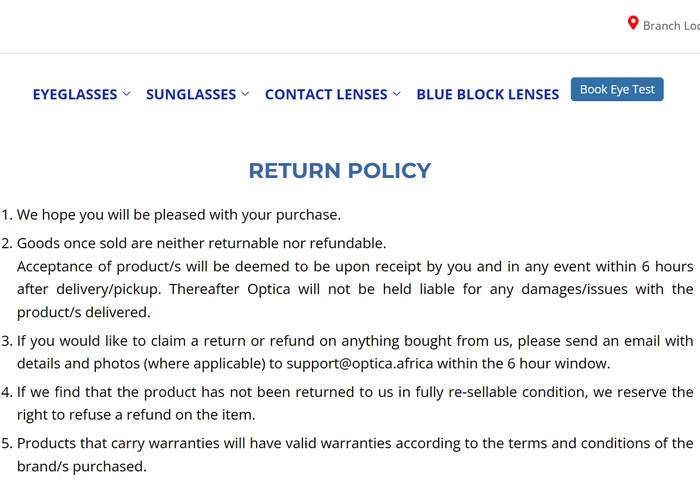How to Write An E-commerce Refund Policy That Wins Customers Over
Jun 13, 2023
Few things in ecommerce are as dreaded as refunds. Learn how a well-crafted ecommerce refund policy can turn refunds from a plague to a source of new customers.
Returns and refunds are an inescapable reality of e-commerce in Kenya and worldwide. The reasons for them are many and varied, including:
Goods damaged during shipping or that have missing parts,
some items don’t fit or arrive well past the promised date,
shipped items are ‘not as depicted’ or don’t fully satisfy the customer.
A well-crafted e-commerce refund policy prepares your business for any of these circumstances. If it is balanced, the refund policy can stop customers from taking advantage of you and simultaneously provide clarity for customers, which builds their trust in your brand and sets the right expectations.
An e-commerce refund policy establishes your business as transparent, an attribute online shoppers value that can win over customers that are undecided as to which stores to shop at.
This guide will teach you how to write an ecommerce refund policy that wins customers over, as well as:
what an ecommerce refund policy should include,
types of ecommerce refund policies,
what you should consider before writing your ecommerce refund policy.
We have a lot to get through, so let’s get started.
What is a standard ecommerce refund policy?
An e-commerce refund policy is a statement that outlines how, when, and under what conditions your customers can be refunded for purchases they made on your e-commerce website. It states clearly what can be refunded.
You can give it several names depending on the conditions you set in your refund policy. You can call it a return and refund policy, refund and exchange policy, or shipping and return policy.
Generally, you want a refund policy that sets reasonable conditions for accepting returns and paying refunds. It should protect your business from frequent, unjustified returns and reassure customers that you will grant refunds as long as their reasons for returning items are understandable.
Instead of the chaos-inducing strategy of dealing with returns and refund requests as they come in, it is best to have an ecommerce refund policy in place. Such a policy will stipulate what can and cannot be refunded and who will bear the cost of return shipping.
Return vs refund policy

Returns and refunds are technically different. Returns policies specify if and what can be returned and how long customers must return an item for a refund or exchange.
A refund policy is not contingent on a return and outlines if and when customers can get a refund for a purchase they made on your online store.
That said, you can combine your return and refund policies into one return and refund policy that lays out the conditions for both. Or you can have one or the other, depending on which between them you do not offer.
Kenya does not have an explicit law that governs e-commerce returns. That said, it will reassure your shoppers that they are in the right place and thus benefit your e-commerce business to have a refund policy in place.
Returns can place a huge logistical burden on small e-commerce stores still trying to find their feet. The best way to manage them is to be transparent about handling them.
A refund policy helps to limit returns if it spells out clearly what items can be returned and what you will refund. For example, your return policy might say that sale items and health and self-care products may not be returned. Or that return shipping costs will be borne by the customer.
Sale prices often encourage customers to buy items without consideration for fit and purpose, increasing the chances that some of these may be returned. So making it clear that sale items may not be returned or refunded will remind customers to consider their purchases carefully.
During the holiday season, customers often exhibit bracketing, which is a shopping attitude where they buy the same items in multiple sizes and colours with the intention that they will choose what to keep and return the rest. Your return policy can state how many variations of the same product a customer can return.
Why do you need a refund policy for your e-commerce store in Kenya?
Most of your customers want to see a return and refund policy before they complete a purchase on your online store. Research suggests 92 per cent of them would buy again from you if you made it easy to return purchases.
In e-commerce, shoppers cannot feel or try on a product before they buy. That is a significant source of friction that can lower your conversion rates.
Having a refund policy - preferably putting a link on your checkout page - helps shoppers feel secure and can compensate for hesitancy from being unable to try an item before buying it.
Online shoppers need clarity on how e-commerce brands handle post-purchase service. A refund policy reassures them that you don’t consider a successful checkout as the end of your relationship with shoppers. In that regard, it sets the right expectations for future business and helps to boost customer retention.
Types of ecommerce refund policies
E-commerce shoppers decide where to shop based in part on which store has the best refund policy. So a good ecommerce refund policy for your online store in Kenya must strike a balance between protecting your business and reassuring your customers that they have recourse in the event of the purchase or its process.

The refund policy you choose for your business depends on several factors. These include the type of product you sell, your service area, and the cost of shipping the product back.
For example, perishable products, swimwear, and underwear cannot be returned for health and hygiene reasons. Another instance where returns may not be possible is if you sell to international clients. There are other instances that will cover in the six types of return and refund policies below that call for specific conditions for a refund:
No-refund policy
With a strict no-refund policy, you clarify that you do not accept returns and cannot offer refunds. While this refund policy maximises profit per sale and helps keep a tighter handle on inventory, it puts all the risk on the buyer, which can cause distrust among your customers.
You may adopt a no-return policy if you sell low-value products that make accepting returns and all their associated costs unsustainable. This policy also makes sense if you sell custom-designed, unique art pieces, refurbished, end-of-the-line, and other types of stock for which there cannot be replacements.
Limited return policy
You can settle on a limited return and refund policy to limit the cost of your business. So unless the customer is returning a damaged or faulty product, you will not offer full refunds, or you will accept returns and pay the refund, but the customer will pay for the return shipping.
To cushion the blow of having to pay for return shipping, you can deduct the shipping cost from the refund you will pay.
A limited refund policy can help discourage impulse returns, keeping your return rates and costs sustainable. At the same time, it helps take some of the financial risks from the customer and, in the process, removes hesitations they may have.
Store credit or exchange only
If your margins are too low for a lenient return and refund policy but still worry that a no-return policy can scare away customers, you may offer a store credit or exchange-only policy. With this policy, you promise to do right by the customer, but only that it will not be through a refund.
Instead of offering a refund, you will provide store credit. Where, for example, the return for the return is that the size of the item is too small, your return policy may offer to exchange it with the right-sized item.
Store credit or exchange-only policies are great for online clothing boutiques and sellers of handmade and one-of-a-kind products. It minimises perceived risk for the buyer while simultaneously minimising bracketing and helping to control inventory fluctuations.
Free return policy
A free return policy is where you assume all the financial risks associated with an ecommerce return, including the cost of the refund and the return shipping. It makes sense if you sell high-value electronics and furniture for which there are price-based buying hesitations.
But before you offer a free return and refund policy, be sure you have accounted for all the associated costs. For example, where you already provide free shipping, there may be other options than offering free return shipping.
If you can justify the cost, a free return policy can endear you to customers, lead to large cart sizes, and set up apart from the competition. Know, however, that once you have started offering this policy, you can’t remove it without harming your relationship with customers.
A free return policy may encourage bracketing, so you must implement safeguards to ensure customers don’t abuse the privilege.
Flat-fee return and refund policy
With a flat-fee return policy, you promise to pay only a part of the cost of returning an item. This refund policy is used to limit the number and costs of returns. Depending on the quantity, size, and weight of the items being returned for refund, you can offer to pay a minimum amount to cover the cost of return shipping.
This refund policy allows you to split the cost of returns between you and the customer. At the same time, it reduces the buyer’s perceived risk, which helps to create a good customer experience. This refund policy can, however, be difficult to administer if you sell many different-sized products.
Returnless refund policy
A returnless refund policy means the refund is independent of the product being successfully returned. It works where a product may be too damaged to be repaired and too costly to ship back.
So instead of dealing with the logistical challenge and cost of return shipping, you will pay the refund and ask the customer to dispose of the product themselves.
This policy works when the product arrives in a defective state, and you sell low-price items for which the cost of return shipping may wipe the profit margin. It works because the customer will feel trusted and appreciated, which can position you favourably against competitors.
How to write a great eCommerce return policy
There are several factors you must consider when writing an e-commerce return policy. Many of these depend on the stage of your business.
Small online stores may be more concerned with limiting the volume of returns, worried about return shipping costs and the mere logistical challenge of it.
On the other hand, established e-commerce players like Jumia may use their return policy as a competitive tool. They could offer a return policy with more lenient terms to attract customers away from rival marketplaces and smaller online stores.
With that said, here is what to consider when writing a return and refund policy for e-commerce business in Kenya:
Decide on a type of refund policy.
When choosing a refund and return policy, consider the stage of your business. A free return refund policy for one can impair new, small online stores that are still finding their feet. A limited return policy template may support your business while meeting customers’ minimum expectations.
Add details for your ecommerce refund policy.
Carefully consider your product offering and the scenarios under which customers may return purchases and demand refunds. A good refund policy must address these scenarios without involving your customer service team.
Generally, your refund policy must address these main areas:
Acceptable condition
The return and refund policy must address what condition returned goods must be in to qualify for refund. You may want clothes to be unworn, have their tags on, and be in their original packaging.
Return window
A good return policy must clearly state how long customers must return purchases to receive a refund and what happens if they don’t return the goods within that time.
A longer return window may seem disadvantageous to the merchant, but it may prevent customers from making impulsive return decisions because they don’t have much time to decide. A shorter return window may also hurt the overall customer experience.
Available refund options
Refunds do not have to be in cash only. You could offer to exchange the returned product for the right size and colour or a new one in good condition if the reason for the return was that the item was damaged during shipping.
If you offer exchanges, the refund policy must address what happens if the original product is no longer in stock. Do you exchange with a lower or higher-value product or store credit?
Cost and logistical challenge of return shipping
Return shipping presents both cost and logistical issues for the merchant. These are usually the main reasons merchants choose not to accept returns. Decide what costs or fraction of it you can absorb, remembering that these will be eating into your profits.
You may offer a prepaid return label or charge a handling fee. For items you may refund without the return, decide what circumstances you must obtain and if the refund will be in cash or store credit. Can you offer lower return fees for repeat customers?
Be as detailed as you need to be so customers can understand it fully. While you should be direct in your language, avoid being confrontational. Treat your refund policy as an opportunity to go the extra mile and make your customers happy.
Also, consider adding an FAQ section addressing related questions you can’t include in the refund policy. Ask your customer service agents for the frequently asked questions, and answer those in your FAQs section.
Formulate a return management process.
Without a process and systems within which you manage your returns and refunds, even the best-crafted refund policy will not achieve its intended goals. You must establish an automated system for accepting and tracking returns and refunds.
Shop for returns and refund automation software that integrates with your e-commerce platform. Some of these can enable self-service returns, automate critical steps of the process, and even generate free return labels.
If you lack the resources, engaging a third-party logistics company to handle return shipping is a good idea. These companies offer expanded services, including sorting returns to decide which ones can be resold, even before pick-up and return shipping, which can save you costs.
Decide where to place your refund policy on your website.
A refund policy is no good if customers cannot access it. If you cannot display it on your homepage footer or checkout page, you may not have bothered creating one.
Good places to add a link to your return and refund policy are on the website footer, product pages, FAQs page, and in your abandoned cart emails. Placing a clearly labelled link in the footer ensures customers can access whatever page they are on.
The effort to make sure customers see your refund policy presents you as trustable and sets the right expectations for your future dealings with customers.
An e-commerce refund policy is central to customer experience.
A return and refund policy is now a must-have for e-commerce websites, even if theree is no la that legislates for one. It has grown in importance from a mere trust-building tool to something central to customer experience. You will lose customers if you don’t have one.
That said, an e-commerce refund policy should not be reduced to any other business document you must write. It is a critical customer communication tool that must acknowledge that online shopping differs from in-person shopping and that by using it, customers are assuming a certain level of purchase risk.
Because a lot can go wrong between you accepting a customer’s order and the customer receiving it, some of which is out of your and the customer’s control. So your refund policy must be reasonably accommodating and written in warm language.
You may not offer a ‘no questions asked, free return’ policy, but make sure the refund policy raises reasonable conditions and settles the customer’s request to a point without sacrificing your business’s bottom line.
IntaSend is a payment gateway for e-commerce brands in Kenya and beyond. Our payment gateway helps you accept customer payments on your Shopify or WooCommerce website, whether they are using Visa, Mastercard, Bitcoin, or M-Pesa.
Sign up with IntaSend today and enjoy frictionless e-commerce checkouts at the lowest fees on the market.

